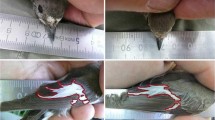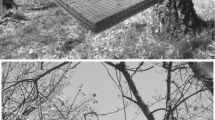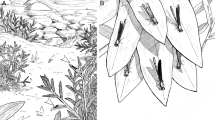Summary
Scarlet-tufted malachite sunbirds (Nectarinia johnstoni) are endemic to the alpine zones of East African mountains. On Mount Kenya they feed almost exclusively on the nectar of Lobelia telekii flowers. Males are resident on their territories all year and defend L. telekii inflorescences from conspecifics. Males are bright iridescent green, with scarlet pectoral tufts which are displayed prominently during aggressive interactions with other males. We investigated the role of pectoral tufts in territory defence using natural variation and experimental manipulation. Males with naturally large pectoral tufts defended more L. telekii inflorescences than males with smaller tufts, and achieved a higher reproductive success. Males were subjected to one of three experimental treatments - having their pectoral tufts enlarged, reduced or manipulated but kept at the same size. Males with reduced tufts spend more time in aggressive interactions than the control males, the interactions lasted longer and they lost a number of inflorescences to neighbours. Males with enlarged pectoral tufts increased the number of inflorescences defended. These results indicate that the pectoral tufts of male scarlet-tufted malachite sunbirds are used as a means of male-male assessment during aggressive interactions.
Similar content being viewed by others
References
Baker RR, Parker GA (1979) The evolution of bird colouration. Phil Trans Roy Soc Lond B 287:63–130
Butcher GS, Rohwer S (1989) The evolution of conspicuous and distinctive coloration for communication in birds. In: Power DM (ed) Current ornithology, vol 6. Plenum Press, New York London, pp 51–108
Coe MJ (1967) The ecology of the alpine zone of Mount Kenya. Junk, The Hague
Darwin C (1871) The descent of man, and selection in relation to sex. John Murray, London
Dawkins MS, Guilford T (1991) The corruption of honest signalling. Anim Behav 41:865–873
Eckert CG, Weatherhead PJ (1987) Ideal dominance distributions a test using red-winged blackbirds (Agelaius phoeniceus). Behav Ecol Sociobiol 20:43–52
Evans MR (in press) The size of male adornments varies with environmental conditions, as predicted by handicap theories. Anim Behav
Evans MR, Hatchwell BJ (1991) An experimental study of male adornment in the scarlet-tufted malachite sunbird: II the role of the elongated tail in mate choice and experimental evidence for a handicap. Behav Ecol Sociobiol 29:421–427
Fugle GN, Rothstein SI, Osenberg CW, McGinley MA (1984) Signals of status in wintering white-crowned sparrows, Zonotrichia leucophrys gamelii. Anim Behav 32:86–93
Grafen A (1990a) Sexual selection unhandicapped by the Fisher process. J Theor Biol 144:413–516
Grafen A (1990b) Biological signals as handicaps J Theor Biol 144:517–546
Hansen AJ, Rohwer S (1986) Converable badges and resource defence in birds. Anim Behav 34:69–76
Hill GE (1990) Female house finches prefer colourful males: sexual selection for a condition-dependent trait. 40:563–572
Järvi T, Bakken M (1984) The function of the variation in the breast stripe of the great tit (Parus major). Anim Behav 32:590–596
Møller AP (1987a) Social control of deception among status signalling house sparrows Passer domesticus. Behav Ecol Sociobiol 20:307–311
Møller AP (1987b) Variation in badge size in male house sparrows Passer domesticus: evidence for status signalling. Anim Behav 35:203–210
Moynihan M (1960) Some adaptations which help to promote gregariousness. In: Bergman G, Donner KO, van Haartman L (eds) Proceedings of the XII international ornithological congress. Tilgmann Kirjapaino, Helsinki, pp 523–541
Peek FW (1972) An experimental study of the territorial function of vocal and visual display in the male red-winged blackbird (Agelaius phoeniceus). Anim Behav 20:112–118
Rohwer S (1975) The social significance of avian winter plumage variability. Evolution 29:593–610
Rohwer S (1977) Status signalling in Harris' sparrows: some experiments in deception. Behaviour 61:107–129
Rohwer S (1982) The evolution of reliable and unreliable badges of fighting ability. Am Zool 22:531–546
Rohwer S (1985) Dyed birds achieve higher social status than controls in Harris' sparrows. Anim Behav 33:1325–1331
Rohwer S, Ewald PW (1981) The cost of dominance and advantage of subordination in a badge signalling system. Evolution 35:441–454
Rohwer S, Rohwer FC (1978) Status signalling in Harris' sparrows: experimental deceptions achieved. Anim Behav 26:1012–1022
Rohwer S, Røskaft E (1989) Results of dyeing male yellow-headed blackbirds solid black: implications for the arbitary identity badge hypothesis. Behav Ecol Sociobiol 25:39–48
Røskaft E, Rohwer S (1987) An experimental study of the function of the red epaulettes and the black body colour of male red-winged blackbirds. Anim Behav 35:1070–1077
Smith DG (1972) The role of epaulettes in the red-winged blackbird (Agelaius phoeniceus) social system. Behaviour 41:251–268
Studd MV, Robertson RJ (1985) Evidence for reliable badges of status in territorial yellow warblers (Dendroica petechia). Anim Behav 33:1102–1113
Tyler S (1979) Time-sampling: a matter of convention. Anim Behav 27:801–810
Williams JG (1951) Nectarinia johnstoni: a revision of the species together with data on plumages, moults and habits. Ibis 93:579–595
Author information
Authors and Affiliations
Additional information
Offprint requests to: M.R. Evans
Rights and permissions
About this article
Cite this article
Evans, M.R., Hatchwell, B.J. An experimental study of male adornment in the scarlet-tufted malachite sunbird: I. The role of pectoral tufts in territorial defence. Behav Ecol Sociobiol 29, 413–419 (1992). https://doi.org/10.1007/BF00170171
Received:
Accepted:
Issue Date:
DOI: https://doi.org/10.1007/BF00170171




